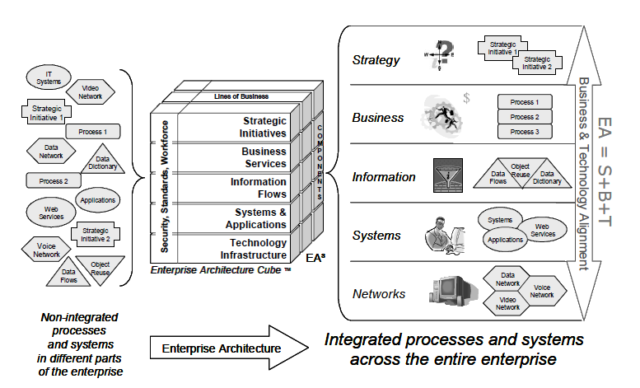Enterprise Architecture Planning – 2
According to Scott A. Bernard (2005, P31), Enterprise Architecture is a profession and management practices that appear intended to improve corporate performance by enabling them to see the company’s own self holistic and integrated view of their strategic direction, business practices, information flow, and technological resources.
EA = S + B + T
Enterprise Architecture = Strategy + Business + Technology
Figure 1. Basic Enterprise Architecture
Enterprise Architecture (EA) is a statement of how an organization to start and produce good order on the implementation of IT and business processes within an organization to increase competition (Ross et al, 2005).
Figure 2. Enterprise Architecture Integrates Strategic, Business, and Technology Planning
According Pearlson and Saunders (2010: 171), Enterprise Architecture is a term that is used to set the logic for the entire organization, often determines how information technology to support business processes.
Enterprise Architecture components typically include four key elements:
- Core business processes-the keycompaniesthat createcapabilitiesthat companies use torun theoperating modelandcreate market opportunities.
- Sharingof data-the datathat drivesthe coreprocesses.
- Connectingandautomationtechnology-software, hardware, andnetworktechnologyprovides a linkbetweenthe application(app itselfispartofthe ITarchitecture, but the waythe applicationwillconnecttogetheris partofthe bigger pictureofenterprise architecture).
- Customergroup-the way customerswillbe servicedby the architecture.
Based on the conclusion of Enterprise Architecture is an asset-based strategy that describes information about business processes, as well as the organizing principle of the mission and demonstrate new technologies that are needed in response to changes in mission and simplify business processes in development as a standardized model of operations at a company.
The Benefits of EnterPrise Architecture are :
- Able tocapture thefactsaboutthe mission, functions, andbusinessfoundationin a form thatis understoodto supportplanninganddecision-makingaregood.
- Canimprove communicationbetweenITandbusinessorganizationsin theenterpriseusinga standardvocabulary.
- Focus onstrategic useoftechnologyforenterpriseinformationmanagementand increase theconsistency, accuracy, timely, integrity, quality, availability, access, andshareinformationinenterpriseITmanagement.
- Achievingeconomies of scale byprovidinga mechanismto shareservicesacross the company.
- Acceleratethe integration ofexistingsystems, migration, andthe new.
- Ensurecompliance with lawsandregulations.



